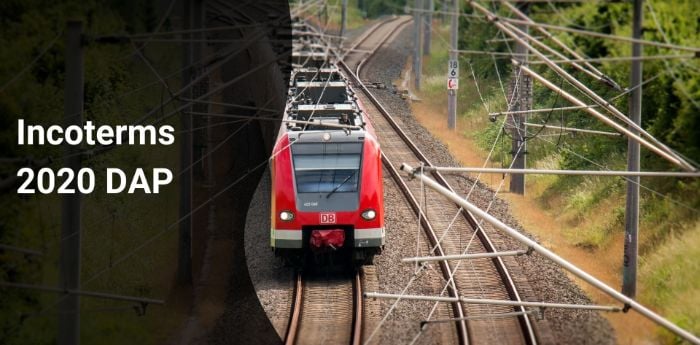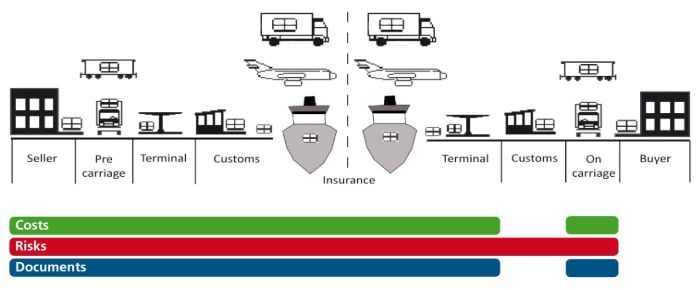The seller and buyer must agree on a destination when using DAP. DAP, or Delivered At Place, can be a difficult process to understand for some users. If you’re thinking of choosing this international trade term, you should know the details of the DAP.
We have been in the sourcing business for the past ten years. Our businesses accommodate land, sea, and air transport. So, we know the ins and outs of all the trade terms, including the DAP incoterms. You will know if the DAP is the proper trade term for your shipment needs.
The following article will help you understand the DAP Incoterm and help you know when to use it.

What is DAP incoterms?
DAP is a Shipping Incoterm that refers to “Delivered at Place.” When delivering the products to the agreed location or point, the seller bears all risks. After the cargo arrives, the buyer pays for applicable taxes and import duties. It may include delivered duty paid, local taxes, and import clearance.
When to use DAP incoterms?
DAP is appropriate for any method of transportation, including intermodal transport. The seller pays for transportation. The seller also has to pay for the transportation to reach the agreed importing country and named destination. For example, “DAP, Port of Los Angeles” transportation.
I usually pay the FEE for shipping to the DAP. It is a good idea to know the COST before you ship.
What are the Buyers and Sellers’ Responsibilities with DAP incoterms?
When the buyers and sellers make a DAP agreement, they must follow the rules. They have to perform some mandatory responsibilities and duties. They must perform these duties to ensure an appropriate deal. The following are the responsibilities and duties of both the Buyer and Sellers:
Responsibilities of Buyers:
- Goods Payment
- Paying the custom handling fees at the agreed destination
- Payment of Taxes, Unloading Costs, local Import Duty, and Other Costs
Responsibilities of Sellers:
- Delivery of the Required Documents and Goods
- Wrapping and Proper Packaging of the Goods
- Inland Transportation in the Origin Country
- Pay the Custom Handling Fees in the Country of Origin
- Pay the Loading Charges for the Product
- Charges of Origin
- International Transportation Charges
- Charges of Destination
- Inland Transportation to the Agreed Destination Country

Pros and Cons of DAP incoterms
Even with the well-defined criteria for DAP agreements, disputes might arise. It can be when the goods carrier gets charged demurrage. It happens when one of the parties does not have enough clearance. Some of the advantages and disadvantages of DAP.
Pros of DAP:
- The buyer can know which party handles extra true shipping costs. The seller takes any extra charges incurred during the shipment procedure.
- Customers who put all shipping terms on the seller can take advantage of DAP. It provides small liability options and widespread agreement.
- DAP can help purchasers manage their cash flow and inventories better. It is useful when purchasing expensive goods from vendors.
- I know what my RESPONSIBILITIES are. DAP incoterms simply define tasks. After that, it is EASIER to complete.
- For the buyer, it is a win-win situation. Customers can place smaller orders and get them at a quick pace.
Cons of DAP:
- DAP incoterms could cause snags in your workflow. Usually, customs clearance occurs before the cargo reaches the customer’s destination. It means customs must allow the item to pass before it gets delivered to the buyer. Due to delays, and detention, the customer will be responsible for these extra costs.
- If a buyer uses a 3rd party logistics or freight forwarder, the total cost will be higher.
- DAP can also pose a risk for some vendors. It is when sent to new purchasers in these circumstances. One of the main problems a seller faces is that the buyer may refuse to take items.
- To keep the shipping terms sustainable, sellers are aware of these certain risks. They need to take steps to clear them, such as increasing deposits or charging higher charges.
A Fast , Easy and Cheap Way to Ship from China
Do not hesitate to contact Leeline Sourcing at any time regarding your shipments from China.
DAP incoterms Risks
There are many risks involved when it comes to DAP. While goods are in transit, the seller handles all costs and hazards. It is until the times reach their final destination under Incoterms 2020 guidelines. At this stage, risk transfers from seller to buyer.
The customer handles all fees related to taking the control of the products and clearings. If the items don’t reach a timely way, the buyer’s responsibilities increase. Customs costs, charges, taxes, inspection fees, and storage fees become buyer responsibilities. The seller must work with the buyer customs broker to ensure export clearance.
DAP Incoterms Example

To buy a consignment of goods, a buyer in London enters into a DAP agreement with a seller in New York. The seller from New York must pay for the transport costs. He will have to pay for the items from their storage facility to the destination in London.
If any harm occurs to the items during transport, the seller handles repairs. He will have to pay for import duty and other imposed charges when the shipment reaches London. If the London Port is the final destination in the contract, the seller should not pay the freight. Yet, the seller must cover the buyer’s premises as the terminal destination.
Suggested reading: Alibaba DDP Shipping
FAQs about DAP
What is the difference between DAP and CIF?
CIF means that the seller is responsible to pay the shipping costs of the package. He has to perform the necessary steps for arranging insurance. As a result, the customer handles shipment and customs costs. Under DAP, the seller’s maximum responsibility is to pay for additional costs. These cost include unloading and customs duties.
Who pays DAP freight?
The seller handles all shipment logistics and shipping costs under the DAP agreement. After the arriving means, the buyer takes responsibility for all the charges.
How Delivered-at-Place (DAP) Works?
Sellers bear all the risk of delivering to an agreed-upon location when offering DAP. It is the seller’s responsibility to arrange the items properly. Everything, from export packaging to documentation, is the seller’s responsibility.
Does DAP include unloading?
The buyer is responsible for unloading the items at the delivery destination port as part of the DAP.
What is the difference between DAP and DAT?
The important difference between DAP and DAT is: The unloading of products at the DAP dock port is the buyer’s responsibility. In contrast, it is the seller’s responsibility in DAT.
What’s Next
DAP is one of the most valuable terminologies in international trade. It provides considerable advantages to buyers and sellers. The buyer and seller should agree on who would pay for extra expenses when applicable.
If you need some shipping services, you can contact us. We will help you deliver your goods safely to your designated destination.








